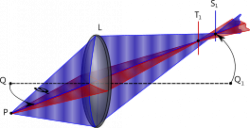Single Vision

Myopia (or nearsightedness) – the inability to see clearly at a distance.
Nearsightedness is a result of the eye being slightly longer than usual from front to back. This can cause images to focus in front of the retina instead of directly on its surface. As a result, far objects appear blurred and are difficult to focus upon. Myopia is measured using negative diopters. The further the number of diopters is from zero, the more pronounced the myopia or nearsightedness. Nikon offers a variety of single vision lenses designed to correct this condition and allow for a return to normal vision.
Nearsightedness is a result of the eye being slightly longer than usual from front to back. This can cause images to focus in front of the retina instead of directly on its surface. As a result, far objects appear blurred and are difficult to focus upon. Myopia is measured using negative diopters. The further the number of diopters is from zero, the more pronounced the myopia or nearsightedness. Nikon offers a variety of single vision lenses designed to correct this condition and allow for a return to normal vision.

Hyperopia (or farsightedness) – the inability to see clearly up close.
This condition occurs when the eye is too short from front to back. As a result, images focus behind the retina instead of directly on its surface. When people are farsighted, close objects appear blurry and difficult to focus on. Hyperopia is measured in positive diopters. The farther the number of diopters is from zero, the more pronounced the farsightedness. Nikon has a variety of single vision lenses designed to eliminate the problems of hyperopia for a return to a more normal, natural vision.
This condition occurs when the eye is too short from front to back. As a result, images focus behind the retina instead of directly on its surface. When people are farsighted, close objects appear blurry and difficult to focus on. Hyperopia is measured in positive diopters. The farther the number of diopters is from zero, the more pronounced the farsightedness. Nikon has a variety of single vision lenses designed to eliminate the problems of hyperopia for a return to a more normal, natural vision.

Astigmatism – rather than just being blurred, an image appears distorted, causing imprecise vision at any distance.
Astigmatism is a refractive error caused by an irregularly shaped cornea, appearing more oblong, like a football, as opposed to the more normal spherical form. Measured in diopters, cylinder meridian or axis, astigmatism can cause double images or ghosting. These visual distortions can be corrected with any of a variety of single vision lenses designed to help you see the world as it actually exists.
< back
Astigmatism is a refractive error caused by an irregularly shaped cornea, appearing more oblong, like a football, as opposed to the more normal spherical form. Measured in diopters, cylinder meridian or axis, astigmatism can cause double images or ghosting. These visual distortions can be corrected with any of a variety of single vision lenses designed to help you see the world as it actually exists.
< back
